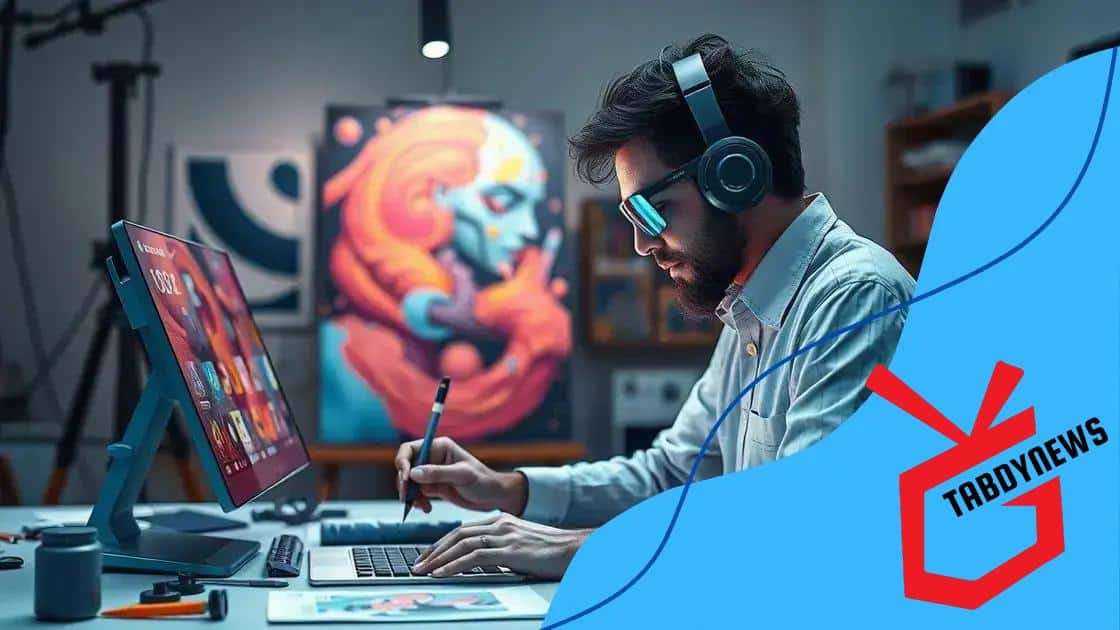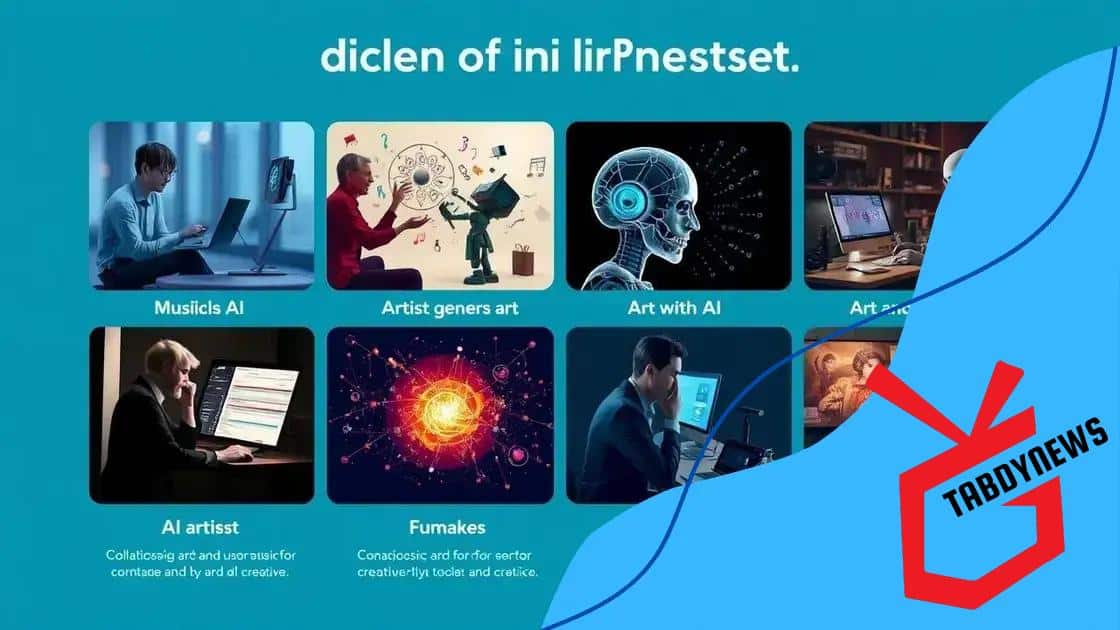The role of AI in transforming the creative industries

The role of AI in transforming the creative industries includes enhancing artistic expression, improving efficiency, and enabling deeper collaboration, while facing challenges such as resistance to change and ethical concerns.
The role of AI in transforming the creative industries cannot be overstated. As we explore how technology is reshaping artistic expression, it’s fascinating to think about the new possibilities that emerge every day. Are you ready to uncover the impact?
Understanding AI’s influence on creativity
Understanding how AI influences creativity is crucial in today’s rapidly evolving landscape. Artists and creators are beginning to see the potential that artificial intelligence can offer in their work. It’s not just about creating new pieces; it’s about enhancing existing skills and exploring unseen avenues.
The synergy between AI and human creativity
AI serves as a powerful tool that collaborates with artists. This collaboration leads to extraordinary results by merging human intuition and machine precision. As the technology improves, it becomes easier for creators to leverage AI in ways that were once unimaginable.
Key areas where AI enhances creativity
- Music composition, where algorithms can suggest new melodies and harmonies.
- Visual arts, enabling artists to create unique designs and artworks.
- Writing assistance, providing suggestions to enhance narratives and generate ideas.
- Game design, where AI helps create immersive storylines and engaging environments.
With each passing day, the possibilities expand as more creators adopt AI into their workflows. For instance, musicians can now create tracks with the help of AI-powered software that suggests chord progressions and beats. Similarly, visual artists can use AI tools to generate artwork based on their input, leading to innovative expressions.
A notable example is the use of machine learning by designers to refine their work. By analyzing large datasets, these tools can identify trends and suggest improvements. This not only provides insights but also inspires creative directions that artists may not have considered.
Moreover, in industries like advertising, AI is revolutionizing how campaigns are formulated. It allows for personalized content creation that resonates with audiences at a deeper level. This application showcases how integrating AI can result in more targeted and effective outreach.
As we continue to explore the interaction between technology and creativity, it’s essential to understand that AI does not replace human creativity; it transforms it. By enabling artists to push boundaries, AI fosters a new era of creative exploration.
Key benefits of AI in the arts
Exploring the key benefits of AI in the arts reveals how technology enhances creativity and innovation. By integrating artificial intelligence into artistic processes, creators can unlock new potentials that were previously unimaginable.
Enhanced Artistic Expression
One of the most notable benefits is the enhancement of artistic expression. Artists can use AI tools to generate unique ideas and explore various styles. This leads to a broader range of artistic outputs, pushing the boundaries of what is considered traditional art.
- AI can analyze millions of artworks to suggest techniques and styles.
- It can create original pieces based on the artist’s preferences.
- Artists can experiment with AI-generated suggestions, enriching their vision.
By collaborating with AI, creators can produce works that blend human emotion with machine precision. This synergy fosters a creative environment where both artists and AI thrive.
Increased Efficiency and Productivity
Another significant advantage is increased efficiency. AI can handle repetitive tasks, freeing up artists to focus on their creative vision. For example, in graphic design, AI tools can automate color matching, layout design, and image enhancement.
This efficiency allows artists to spend more time on ideation and execution. They can quickly iterate on concepts without getting bogged down in time-consuming tasks.
Furthermore, AI can offer valuable insights into current trends and audience preferences, helping artists create relevant and engaging content. This data-driven approach reduces the guesswork traditionally associated with art marketing.
Accessible Creativity
AI also helps democratize art. Improved accessibility means that more people can engage in creative processes. AI art tools are becoming more user-friendly, allowing non-professionals to create stunning artworks.
- Platforms now offer AI-driven templates and tutorials.
- Individuals can explore their artistic talents through intuitive applications.
- Creative expression becomes available to everyone, regardless of skill level.
This shift enables diverse voices to join the artistic conversation and contribute to the cultural landscape.
Case studies of AI in creative sectors

Case studies of AI in creative sectors showcase the incredible transformations happening across various artistic fields. These real-life examples demonstrate how professionals are harnessing artificial intelligence to enhance creativity and streamline their processes.
Music Industry Innovations
In the music industry, AI tools are revolutionizing how songs are composed and produced. For instance, programs like AIVA and Amper Music use AI algorithms to analyze music theory and generate original compositions. Artists can collaborate with these AI systems to explore new sounds.
- AI can analyze existing music to suggest chord progressions.
- Artists use AI to generate accompaniments for their melodies.
- Personalization of playlists improves listener engagement.
This technology not only aids in composition but also in producing tracks by automating tasks that would typically require time-consuming manual effort.
Visual Arts Revolution
In visual arts, AI-driven platforms like DALL-E and DeepArt allow artists to create stunning visuals. By simply providing a few phrases or images, artists can generate unique artworks that reflect their ideas. This process encourages experimentation and facilitates the creative flow.
The integration of AI in visual art is changing the creative landscape. Artists can effortlessly explore different styles, pushing their boundaries. Furthermore, AI can assist in enhancing existing works by offering suggestions for improvement.
Film and Animation Benefits
The film and animation sectors have also embraced AI technologies. AI tools can automate track analysis, making post-production more efficient. Programs like Adobe Sensei enhance video editing by suggesting edits and effects based on the footage provided.
- AI can analyze scripts for pacing and engagement.
- It assists in creating realistic animations based on character movements.
- AI can predict audience preferences, aiding in content creation.
These advancements improve workflow efficiency and help creators produce films and animations that resonate with audiences.
Future trends in AI for creative fields
Future trends in AI for creative fields are shaping the way artists, musicians, and designers work. As technology progresses, we can anticipate exciting shifts that will redefine creativity and collaboration.
Personalized Creative Tools
One major trend is the development of personalized AI tools. These programs will learn from an artist’s unique style, preferences, and past works. As a result, they can suggest tailored ideas and enhance the creative process.
- AI will adapt to individual workflows, streamlining projects.
- Artists can receive real-time, customized feedback on their work.
- Creative ideas will become more accessible through AI recommendations.
This personalization will create stronger connections between creators and their tools, fostering a more intuitive creative environment.
Collaboration Between Humans and AI
The future will also see deeper collaboration between humans and AI. Rather than being seen as separate entities, AI will be viewed as co-creators. This partnership encourages artists to push boundaries and explore new possibilities in their work.
By integrating AI into various stages of the creative process, artists can gain new perspectives. For example, using AI to visualize concepts can inspire innovative approaches to traditional mediums.
Enhanced Distribution and Audience Engagement
Future AI advancements will improve how artists distribute and engage with their audiences. AI algorithms will analyze viewer preferences and trends, helping creators tailor their content for maximum impact.
- Data-driven insights can guide artists in curating collections and presentations.
- Personalized recommendations will enhance how audiences discover new art.
- Automated marketing strategies will reach wider audiences effectively.
As a result, creators can build meaningful relationships with their fans while expanding their reach into new markets.
Emphasis on Ethical AI Use
Along with technological growth, there will be a rising emphasis on ethical AI use in creative fields. Artists and organizations will begin to prioritize transparency and accountability in AI deployment.
Discussions around copyright, originality, and AI-generated content will shape policies and practices. This awareness will foster a responsible approach to integrating technology into creativity, ensuring that artists’ rights are respected while embracing innovation.
Challenges facing AI adoption in creative industries
Challenges facing AI adoption in creative industries are significant barriers that many artists and organizations encounter. While artificial intelligence offers exciting possibilities, several hurdles must be addressed to ensure successful integration into creative workflows.
Resistance to Change
One of the primary challenges is resistance to change. Many artists feel apprehensive about embracing AI tools because they are accustomed to traditional methods. This reluctance can hinder innovation and the potential benefits of adopting new technology.
- Concerns about losing artistic authenticity in AI-generated works.
- Fear of job displacement due to automation.
- Preference for familiar creative processes over adopting new technologies.
Such resistance can slow down the overall acceptance of AI within various artistic communities.
Access and Affordability
Access to quality AI tools can also be a challenge. Not all artists and organizations have the resources needed to invest in advanced technologies. This creates a disparity between those who can afford AI solutions and those who cannot.
Moreover, the cost of training and implementing AI systems can be prohibitive, especially for small businesses and independent artists. As a result, many talented individuals may not fully utilize AI’s potential.
Ethical Concerns and Copyright Issues
Another significant challenge involves ethical concerns surrounding AI-generated content. Issues of copyright and ownership can arise when AI creates works based on existing materials. Artists are worried about losing their rights and recognition in the creative process.
- Unclear guidelines on copyright for AI-generated art.
- Concerns about plagiarism and originality.
- Potential legal battles over AI’s role in content creation.
Addressing these legal and ethical questions is crucial to fostering a more supportive environment for AI in creative industries.
Technical Limitations
Finally, technical limitations of AI can pose challenges. While AI has made significant strides, it still lacks the emotional depth and nuance that human artists bring to their work. This gap can prevent AI from fully replicating the artistic process.
Additionally, the effectiveness of AI tools depends on the quality of the data they are trained on. Inaccurate or biased data can lead to ineffective or unintended outcomes, making artists cautious about relying on AI solutions.
FAQ – Frequently Asked Questions about AI in Creative Industries
What are some primary benefits of using AI in creative fields?
AI enhances creativity by providing new tools, improving efficiency, and enabling personalized artistic experiences.
What challenges do artists face when adopting AI technology?
Artists often encounter resistance to change, access and affordability issues, ethical concerns regarding ownership, and technical limitations.
How can AI impact traditional artistic methods?
AI can complement traditional methods by automating repetitive tasks and offering new creative insights, but it may also raise concerns about authenticity.
What ethical considerations should be addressed with AI-generated content?
Key issues include copyright ownership, originality, and the potential for bias in AI-generated works, which need clear guidelines to protect artists.





